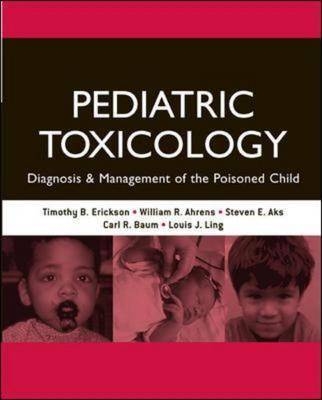
Pediatric Toxicology: Diagnosis and Management of the Poisoned Child
McGraw-Hill Inc.,US (Verlag)
978-0-07-141736-5 (ISBN)
- Titel ist leider vergriffen;
keine Neuauflage - Artikel merken
Evidence-based and age-specific, this book guides the clinician through the diagnosis and management of the poisoned pediatric patient
5 STAR DOODY'S REVIEW!
"This book, the first of its kind and long overdue, is an authoritative text on poisonings in the pediatric population....This is a wonderfully organized book that begins with historical perspectives of the evolving field of toxicology, discusses unique considerations of pediatric patients, reviews prescriptive and nonprescriptive poisonings, common household and environmental poisonings, and methods of decontamination and antidotes....Its organization and clear presentation are only superseded by its complete coverage."--Doody's Review ServiceFeatures high yield facts at the start of each chapter, case presentations throughout, a 200+ question self-assessment section, antidote dosage tables, colour plates, and coverage of herbal products, vitamins, cosmetics, spider bites, and snake bites.
Timothy B. Erickson, MD, Associate Professor, Department of Emergency Medicine, Emergency Residency Program Director, Director, Division of Clinical Toxicology, University of Illinois at Chicago, Chicago, Illinois MD, Associate Professor of Clinical Emergency Medicine, Director of Pediatric Emergency Medicine, University of Illinois at Chicago, Chicago, Illinois Steven E. Aks, DO, Department of Emergency Medicine, Cook County Hospital, Chicago, Illinois Carl Baum, MD, Assistant Professor of Pediatrics, Division of Emergency Medicine, Director of Medical Toxicology, Yale-New Haven Childrens Hospital, Yale University School of Medicine, New Haven, Connecticut Louis Ling, MD, Professor of Emergency Medicine, Division of Clinical Toxicology, University of Minnesota, Hennepin County Medical Center, Minneapolis, Minnesota
1)General Principles of Pediatric Poisoning2) Poison Prevention in the Home3) Poison Control Centers4) Maternal-Fetal Toxicology5) Breast Milk Toxicity6) Toxicity in the Premature Infant7) Special Toxicologic Considerations in the Neonate8)Special Toxicologic Considerations in the Toddler 9)Special Toxicologic Considerations in the Adolescent 10) Pediatric Toxicokinetics and Pharmacology 11)Toxic Syndromes and Toxidrome Recognition 12)Airway Management in the Poisoned Child 13)Advance Pediatric Life Support (APLS) 14) Pediatric Haz Mat15) Weapons of Mass Destruction16)Gastrointestinal Decontamination 17)Antidotes 18)Extracorporeal Removal of Toxins19) Poisoning and the Pediatric Intensive Care Unit20)Laboratory Testing in the Poisoned Pediatric Patient 21)Fluid/Electrolyte Acid/Base Management in the Poisoned Child 22)Thermoregulation in the Poisoned Child 23)Organ System Toxicity 24)Radiologic Findings in the Poisoned Child 25)Lethal Toxins in Small Doses 26) Nontoxic Drugs27) Over the Counter Medications28)Acetaminophen 29)Anticholinergic Poisoning 30)Aspirin Poisoning 31)Nonsteroidal Anti-Inflammatory Drugs 32)Caffeine Toxicity 33)Vitamins 34)Prescription Drugs 35)Antihypertensives, B-blockers and Calcium Antagonists 36)Colchicine 37)Digoxin Toxicity 38)Theophylline 39)Sedative Hypnotics 40)Hypoglycemic Agents and Insulin 41)Antiepileptic Agents 42)Isoniazid Poisoning 43)Antidepressant Overdose 44)Lithium Toxicity 45)Neuroletics and Antipsychotic Drugs 46)Household Poisons 47)Alcohols 48)Caustics: Acids and Alkali 49)Hydrocarbons 50)Mothballs, Camphor, and Deodorizers 51)Organophosphates, Carbamates, Pesticides and Herbicides 52)Rodenticides and Anticoagulants 53)Drugs of Abuse 54)Amphetamines 55)Anabolic Steroids and Hormonal Drugs 56)Cannabinoids 57)Cocaine Toxicity 58)Hallucinogenic Agents 59)Inhalants 60)Opioids 61)Drug Facilitated Sexual Assault 62)Phencyclidine Toxicity 63)Tobacco Products 64)Withdrawal Syndromes 65)Metals Overview 66)Arsenic Poisoning 67)Button Batteries 68)Iron Poisoning 69)Lead Poisoning 70)Mercury Poisoning 71)Blood and Cellular Toxins 72)Carbon Monoxide 73)Cyanide Poisoning 74)Methemoglobinemia 75) Natural and Environmental Toxins76) Herbal Products77) Food Poisoning and Botulism78) Marine Envenomations79) Mushroom Poisoning80) Poisonous Plants81) Snake Envenomations82) Spider and Arthropod Bites83) Study Questions and Answers Color Plates
| Erscheint lt. Verlag | 16.11.2004 |
|---|---|
| Zusatzinfo | 88 Illustrations, unspecified |
| Verlagsort | New York |
| Sprache | englisch |
| Themenwelt | Medizin / Pharmazie ► Medizinische Fachgebiete ► Pädiatrie |
| Studium ► 2. Studienabschnitt (Klinik) ► Pharmakologie / Toxikologie | |
| ISBN-10 | 0-07-141736-2 / 0071417362 |
| ISBN-13 | 978-0-07-141736-5 / 9780071417365 |
| Zustand | Neuware |
| Haben Sie eine Frage zum Produkt? |
aus dem Bereich


